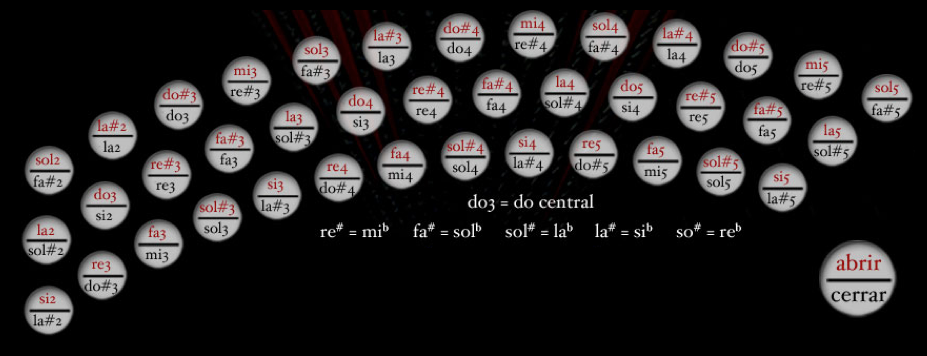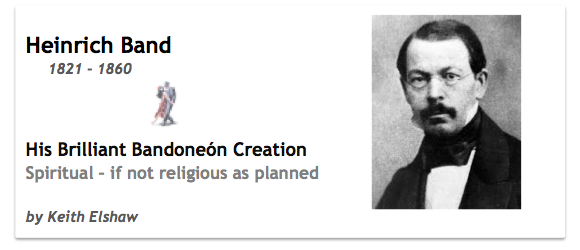Of course there was no such thing as "tango" before it arrived in Argentina; no tango dance, no tango music as we know it. There was only vals and the new 2/4 music of the late-19th century emigrees called "milonga."
Around 1870 down in the docks by the Rio de la plata this awesome new instrument came off a boat and changed the music and dance worlds for all time. Who exactly brought it is unknown to history, but undoubtedly it came via an immigrant or sailor.
We DO know when and where it was created in the first place: it was the invention of Heinrich Band. At the age of 22 he took over his father's musical instruments shop in Krefeld, Germany. In 1846 he formed a group of artisans in order to procure the materials used to make the instruments. The company name? Band-Union. In December, 1850 he announced, "To friends of the accordion: By way of a new invention, we have once again remarkably perfected our accordions, and these new instruments, round or octagonal, from 88 to 144 voices, are available at our store."
And he had conceived it for a very practical commercial reason. Heinrich saw a market in all the small churches of Europe which couldn't afford an organ. If he could only build an instrument that approached the complexity of sound the pipe-organ emitted, he was sure it would be a great success while providing an invaluable aid in the conducting of the music in churches services.
He did it, of course. His new invention was powerful, rich across the audio spectrum and loud enough to fill any country church (and and those in the city).

His thinking was totally on track except for one big flaw: it was very difficult to play. So it never took off in Europe. It needed to emigrate and find a new life and meaning in far-off Argentina. How sad for Heinrich that that would not happen for another three decades. He could never imagine what would transpire when it found its new home.
(Wikipedia: By 1910 bandoneóns were being produced expressly for the Argentine and Uruguayan markets, with 25,000 shipping to Argentina in 1930 alone. However, declining popularity and the disruption of German manufacturing in World War II led to an end of bandoneon mass-production).
An inanimate object possessing a mysterious "personality" as it breathes in and out, it can sound like a choir of voices in a musician's hands. Arresting; powerful; very complex.
It changes your hearing, gives you a truer sense of pitch. It envelops you in a pensive - but - warm and evocative soundscape. Like a blanket it comforts you from the world outside. It draws you in. It grows a deeper relationship between you and tango. It's breathing goes with the dancers' breathing and pumping hearts. What a sublime technical achievement this reed instrument is.
A new instrument in a new land, it played waltzes and polkas, but was soon to join in with the guitars, violins and flutes playing the hot new musical genre being created in Argentina - Milonga. But that music was fast - and nobody playing the bandoneón (they were all new to it) could keep-up with the other players.
The music had to slow down for bandoneón players to join in.
Tango is born.
And almost before you can say "immigrant" ... the Bandoneón becomes the very soul of tango.
Recommended reading:
The Bandonion: A Tango History, by Javier García Méndes and Arturo Penón (Nightwood Editions, London, Ontario, 1988) translated by Timothy Barnard. ISBN 0-88971-111-9
A real treasure! It's an oral history transcribed and I believe the best book ever published in English on the bandoneón's life in tango.


